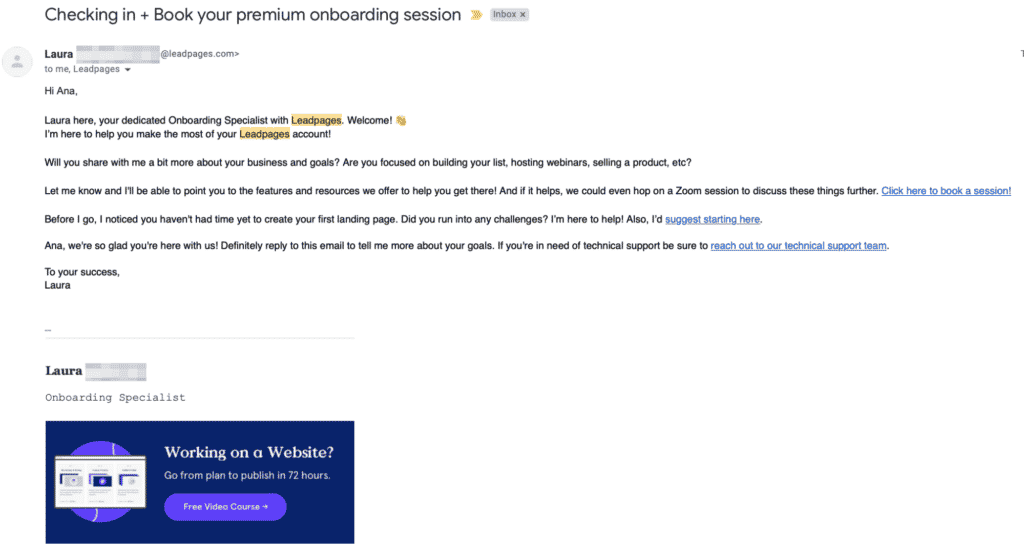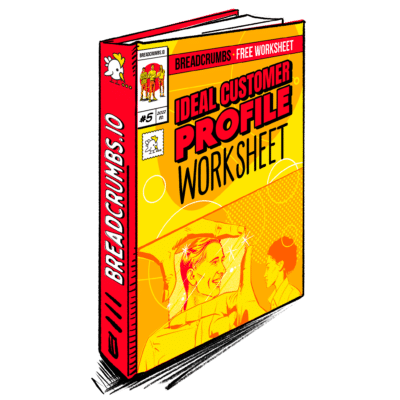“Personalization” is one of the most significant terms in marketing right now.
Since we’re all working harder than ever to make our messaging more relevant to contacts than ever before, this isn’t much of a surprise. It’s hard to get more relevant than personalized content, after all.
But what exactly is personalization in marketing?
In this post, we’re going to look at why personalization is so crucial in and marketing and sales, and we’ll share exactly how you can get started offering custom-to-your-customers messaging that’s sure to increase your conversions and accelerate your revenue.
What is Personalization in Marketing?
Personalization in marketing is the practice of tailoring at least some of your marketing messages, offers, and communications to individual segments of users based on factors like their demographics or online activity.
This can be as small as inserting someone’s name into a subject line with a helpful line of code in an email or as significant as offering custom prices and deals based on the information you have on a lead.
When I signed up for Rover to find dog sitters, for example, they gathered information about our dogs’ names and, of course, the fact that we had dogs.

They’ll send me content specifically tailored to me as a dog owner and often include one or more of our pets’ names in the email. This feels relevant; it jumps out at me as a reader and gets a click.
Why Personalization in Marketing Matters
Personalization in marketing matters because it allows you to create the most relevant content possible for each individual user, and often on a fairly automated basis. This means you’re sending them the right message at the right time, increasing the odds of conversion significantly.
Here’s an example of personalization in marketing from a B2B brand, Leadpages. I got an email from a customer service specialist (which very well could have been an automated message) that did the following:
- Established a “personal” connection (even if it was automated)
- Asked about goals and needs (which is qualifying information)
- Encouraged the user to get in touch or book an onboarding session to get more out of the tool (which can help increase engagement and retention)
- Note that I hadn’t created a landing page yet, and offer resources to get started

This was all tailored to me, and it could very well have been manually created. Either way, it was relevant, and as a user, it gave me everything I needed to engage on multiple levels and gave me the resources to find more value from the tool.
An email like this can re-engage new users of SaaS tools before they end up dropping off after a free trial, and it can keep them engaged and retaining long-term. It moves users to the next point of the buyer’s journey—no matter where they’re at or what your conversion goal is—which is essential.
There’s plenty of data that backs this up, including the following:
- 99% of marketers say personalization improves and advances customer relationships, with 78% saying it had a strong impact
- 80% of customers are more likely to purchase or convert when brands have personalized experiences
- 83% of consumers say they’d give brands more information in exchange for improved, personalized experiences
How to Get Started With Personalization in Marketing
When you’re ready to add personalization to your marketing mix (which should be ASAP if you haven’t done so already), the following steps can help you to incorporate it effectively.
Let’s go step by step through the process of adding personalization to your marketing campaigns.
1. Track Detailed User Data in Your CRM
The first step is to gather as much user data from every contact you have in your CRM.
Only with solid data can you create strong, personalized campaigns that will actually appeal to potential users consistently. Otherwise, you’re looking at a hit-and-miss scenario at best.
Use first-party and third-party data as needed to collect the following information on each contact whenever possible:
- The user’s name and company name
- Qualifying demographic information like industry, company size, revenue, or budget
- Their activity within your tool or on your site
- Their purchase behavior
- Customer support tickets that are opened
- Communications, sentiment, and receptivity in sales calls and emails
- Pages viewed on your site
A high-quality CRM will integrate with other tools that can help you collect, track, and analyze this data so that you can make sense of it and use it for personalization.
2. Understand Your Ideal Customer Profile
The next thing you’re going to want to do in order to improve personalization is to get a really good grasp on your ideal customer profile (ICP).
This essentially gives you a prototype of your perfect customer segment (or segments!) so that you can easily identify them during the sales process.

Ebook
Ideal Customer Profile (ICP) Worksheet
Learn how to create an Ideal Customer Profile and build a successful sales strategy with this Ideal Customer Profile (ICP) Worksheet.
It also, however, allows you to get a solid understanding of who your audience is, what they need, and how they’re going to move through the buying process.
While each customer is an individual—and that’s where personalization comes in—having a solid idea of your ICP can give you insight into these contacts overall and may make personalized campaigns more successful because they’ve got an excellent foundation to start with.
Our tool Reveal can help you find your ICP with just a few clicks, as well as understand how to spot ICP traits in potential leads. See how it works here.

3. Know Where Users Are in Their Buyer’s Journey
You want to know who users are and how they fit into different ICPs and audience segments. (Think “dog owner who wants overnight visits” instead of “cat owner who needs someone to refill food twice a week.”)
That’s step one of creating a personalized campaign.
But it’s also essential to track activity in addition to basic demographics. This can help you determine where users are in their buyer’s journey, gain insight into what offers, products, or features are essential to them, and know what they’re most interested in.
Examples include:
- Sending a follow-up to ask about customer satisfaction after a support ticket was filed
- Creating a custom offer or a discounted offer for users to try the next tier of your SaaS pricing plan after they hit the upper limit of their existing plan
- Reaching out with an enticing offer for users who have stopped purchasing or stopped using the tool
- Following up if users stall during the trial to offer a free onboarding session
- Showing custom deals and offers based on the products and pricing pages users have viewed
Keep in mind that you can create segmented audiences and then run “personalized” campaigns based on this data.
How Contact Scoring Can Help
To best track where users are in their buying journey (and your pipeline!), you can use lead and contact scoring tools like Breadcrumbs.
Breadcrumbs uses a co-dynamic scoring method that accounts for each contact’s firmographic fit and their interactions with your brand.
We can identify users who are showing different indicators that they could be engaged your marketing, and who are high-intent to take an action. This is true whether that action is becoming a new customer or is primed for an upsell to the next tier of your pricing plan. And since we account for both recency and frequency of user actions, this data is always accurate—and actionable.

By better understanding where your leads and contacts are in their journey with your business—and how they’re interacting with your product, support team, and marketing and sales messaging—you can segment users into more niche audiences and send personalized messages accordingly. This can help keep your customers engaged and converting.
And the good news is that Breadcrumbs integrates with popular CRMs and marketing automation platforms (MAPs) like HubSpot, Salesforce, Mailchimp, and Marketo.
We’ll sync data to and from these tools to give you accurate contact scores and to send our lead scores back to the platforms your sales and marketing teams are already using.
You can see how it works in a free demo here.
4. Use Strong Automation-Heavy Tools
Personalization can mean direct emails from the sales team to your customers, but that’s only one facet.
For true success at scale, you’re going to want to look at automated personalization. This works by using personalization tactics (like dropping my dog’s name into an email subject line) and segmentation + trigger-based autoresponders to deliver relevant messages at the right time.
Automation-heavy tools, therefore, should be a go-to.
Examples include:
- HubSpot, Mailchimp, and ConstantContact for email software that can create strong automated and personalized email campaigns
- Twilio or Massente for mass text messaging. Integrating customer service text messaging solutions can enhance your real-time support capabilities, offering personalized and timely responses directly through SMS.
- LeadsBridge or Zapier for syncing user data across multiple platforms, including your CRM, email, and retargeting campaigns for social media.
- Client collaboration software such as PageProof to streamline creative workflow automation.
Most of these tools offer free trials or at least free demos. Make sure that their automated and personalization features are available at the plan within your budget and that the tools integrate with the tech stack you already have.
Personalization in Marketing: Final Thoughts
If you want to increase clicks, engagement, and conversions on all of your campaigns across the board, incorporating personalization in your marketing strategy is going to be essential.
The reality is that customers expect some level of personalization now, and they’ll engage more with brands that are capable of delivering that.
The right tools, of course, are crucial to being able to deliver truly personalized and hyper-relevant campaigns at the proper scale. This includes lead scoring tools like Breadcrumbs to help identify different high-value segments of your audience so you can determine what messages they need to see and when.
Ready to get started with personalization in marketing? Breadcrumbs can help. Book your free demo here!
Frequently Asked Questions
Still have questions about personalization in marketing? We’ve got answers!
What are some B2B examples of personalization in marketing?
These are some examples of personalization in marketing:
- Customizing the “hero” section of your website with headlines or CTAs chosen based off the user’s previous activity with your site.
- Product or plan recommendation campaigns based off CRM data.
- Retargeting ads based on a specific customer’s product usage or recent site activity.
Are there any cons of personalized marketing?
Personalized marketing may require more time, effort, and potentially SaaS tools to execute. That said, the overall payoff is well worth that investment.
Aside from the additional time and resources, some consumers may be concerned about data privacy. Have a privacy policy on your website that assures users that you won’t sell their data to any third-party sites.
What is a personalization strategy?
A personalization strategy is a tactic used by marketing, sales, and even customer service teams to facilitate a truly customized experience for customers. The marketing team, for example, may leverage account-based marketing to deliver personalized ads for employees working for specific brands.
What are the 4 Ps of marketing, and how do they impact personalization?
The 4Ps of marketing are Product, Place, Price, and Promotion. These are essentially four pillars that help you determine what you’re marketing, when, where, and how.
You want to consider these 4Ps when personalizing your marketing campaigns. When it comes to Place, for example, you can offer customized recommendations to users based on their location, and SaaS brands can market custom deals or pricing offers to individual customers based on their needs and usage.



